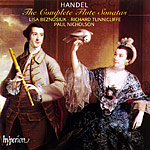While there is no mention of it here, seven out of the eight sonatas performed on this program originally were recorded and issued in 1995 as part of a now long-deleted three-CD Hyperion boxed set (66921/3) that contained all of Handel’s Op. 1 sonatas. The final selection on this new CD, the recently discovered (or “attributed”, as is the case to some extent with nearly all of these sonatas) Sonata in D major, was recorded last January. When that earlier set was released, it was a refreshing alternative to the only other complete Op. 1 traversal available at the time: the staid, often prissy account by L’Ecole d’Orphee on CRD. Anyway, back then I enjoyed how veteran original-instrument flutist Lisa Beznosuik’s interpretations provided a stunning “light” contrast to my longstanding favorite “dark” interpretation–Frans Brüggen’s revelatory 1974 Seon cycle, which was not yet available on CD at the time. (In 1998 Sony finally did release the Brüggen cycle, though unfortunately only in Europe).
Describing Beznosuik’s approach as “light” is by no means pejorative; it’s just that stylistically she heightens the elements of play, humor, and buoyancy incorporated in this music. Take for example her treatment of the Allegro of the E minor sonata HWV 359b, where she sheepishly dots the spright rhythms of the opening passage and spins the melody across both bar and continuo lines. In contrast, Brüggen not only adopts a slower, steadier tempo but alternatively performs on a transverse flute and replaces the harpsichord with an organ continuo. This may be an extreme example, but it typifies how very different these two outstanding interpretations are.
While the newly discovered Sonata in D major HWV 378 does not receive its premiere recording here (Kuijken on Accent can claim that distinction), Beznosuik’s performance is certainly on par with the best. Again, her ability to allow the melody to dance, especially in the two Allegro movements, couldn’t be more inspired, vivacious, and lively. Kuijken’s equally interesting performance nods more toward Brüggen’s interpretations, though unlike the Sony/Seon production, Accent’s recording suffers from a dim, barely audible continuo. As usual with Hyperion, the sonics are lifelike and complementary to instruments and repertoire. The overall presentation is second to none, with informative and entertaining notes by Stanley Sadie. A recording to treasure!
































